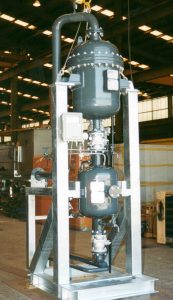Sand Separation & Collection
The first two steps of sand management – Separation & Collection – are often combined to simplify the design process.
The Separation step partitions, or directs, particulate solids contained in a flow stream to one location and fluids (gas, oil, water) to another.
- Solids are dilute dispersed particles while fluid is continuous
- Solids must be separable (inorganic, insoluble, discrete, particulate, heavier density)
- Typically solids go to a static collection location while fluids flow continuously
Solids can be removed in low velocity zones or using enhanced forces:
- Low velocity: bottom of production separator, dead-leg or end-run of pipe, any still spot in tank, treater, or vessel
- Enhanced: cyclonic (wellhead desander or produced water desander), flotation, or impact with retention (screens)
Collection, also called accumulation, gathers the separated solids into one central location to isolate from process flow/pressure.
- Gather: minimize pressure letdown points and simplify handling locations
- Isolate: remove from process flow for further handling without interrupting production
- It is important to remove the sand while minimizing amount of process fluids that tag along
- Jetting systems have large amounts of lost process fluids
Any simple static vessel or chamber that can be isolated, vented, and flushed (batch process) will serve:
- Desanders (multiphase and liquid) use external (secondary) accumulator vessel with clean water bath to minimize hydrocarbon ingress
- Water bath aids sand cleaning and prevents slurry plugging
The photos below show both liquid and multiphase desanders with secondary accumulators.


